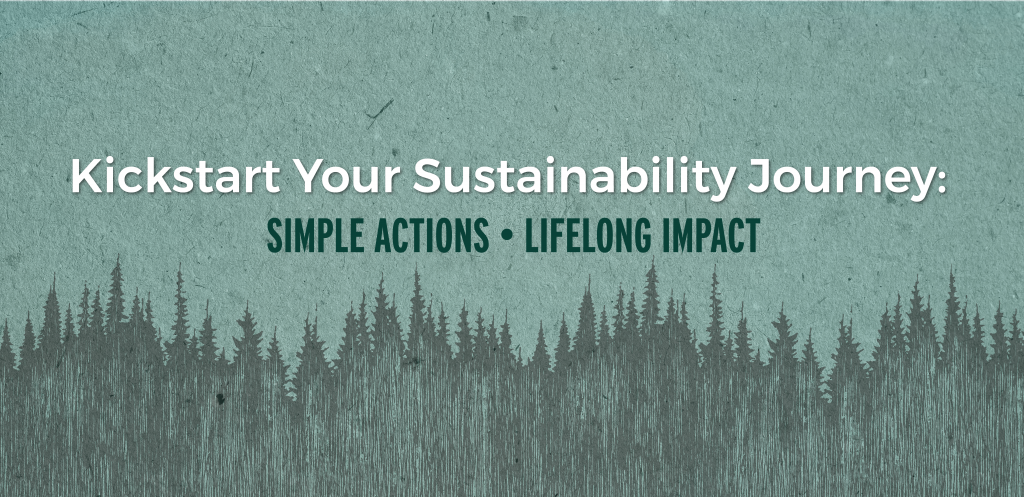
A few years ago, I sewed a bunch of reusable cloth gift bags in cheerful Christmas patterns and they continue to bring me such joy!
I love wrapping presents in these gorgeous bags. I love giving them to people (and am so honored when friends and family want to keep the bag in addition to the gift… in fact, you’ll regularly find me sneaking around and gathering my bags up after gift opening is over at our family gatherings). I love reusing them year after year!
AND they’re super easy to make! I swear, they’re a great project for beginner sewers because it doesn’t matter the size, shape, or even if they’re particularly square. The process is three simple steps: cut, sew, enjoy!
Step 1: Cut your fabric
If the exact size/shape isn’t important to you, I recommend letting your fabric dictate the size.
For example, my fabric is almost 42 inches wide, so I cut it exactly in half and made two 10 inch wide bags. I cut my fabric 15 inches tall and ended up with two 10”x13” gift bags. I love using printed fabric like this because it makes straight cuts easier. I pick a spot in the pattern and cut right along the “line”.
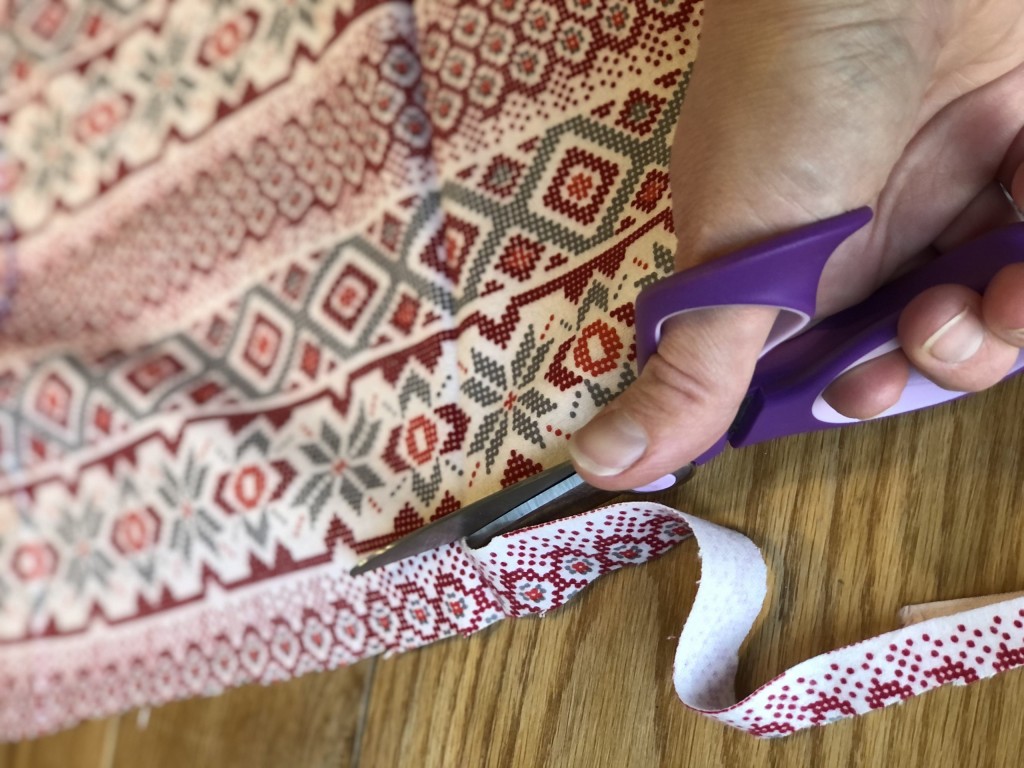
After cutting, my fabric is about 21 inches wide and 15 inches tall.
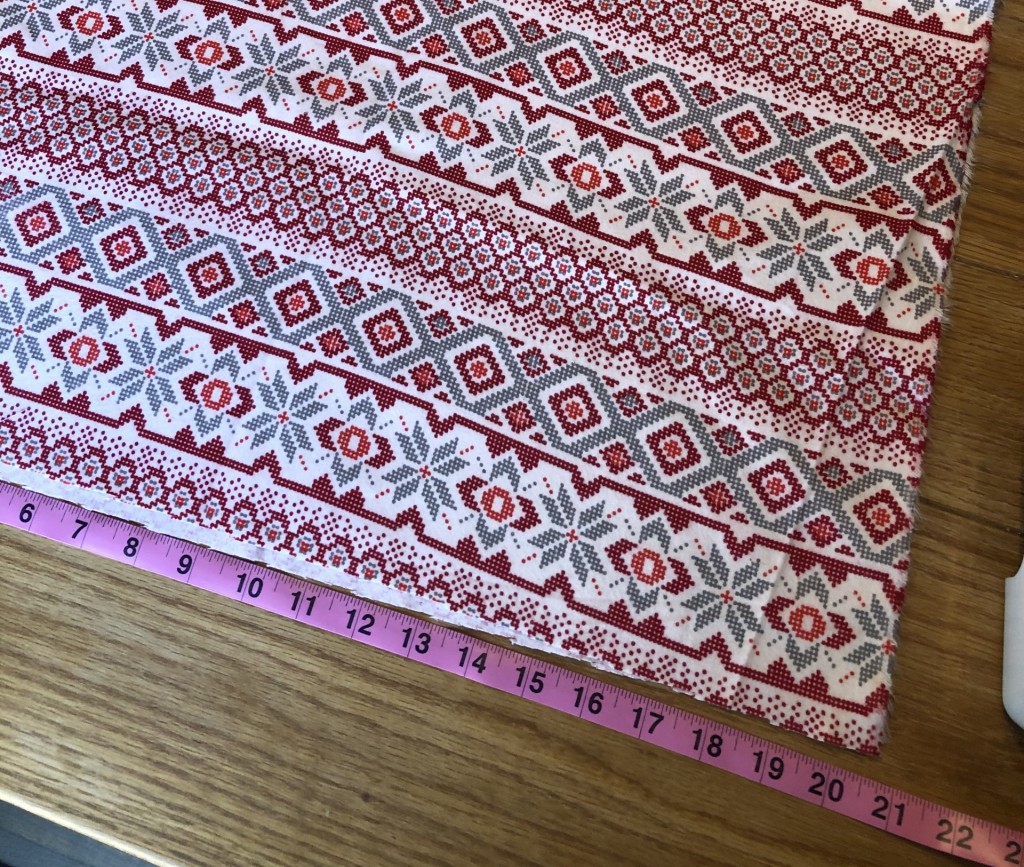
Step 2: Cut your cord
I used 1/4” cotton cord, but feel free to use bigger or smaller. Choose the top of your bag (based on the pattern) and cut your cord at least 8-10 inches longer than the width of your fabric (it will hang out 4-5 inches on either end when you’re done).
My fabric is 21 inches wide, so I cut my cord about 31 inches long.
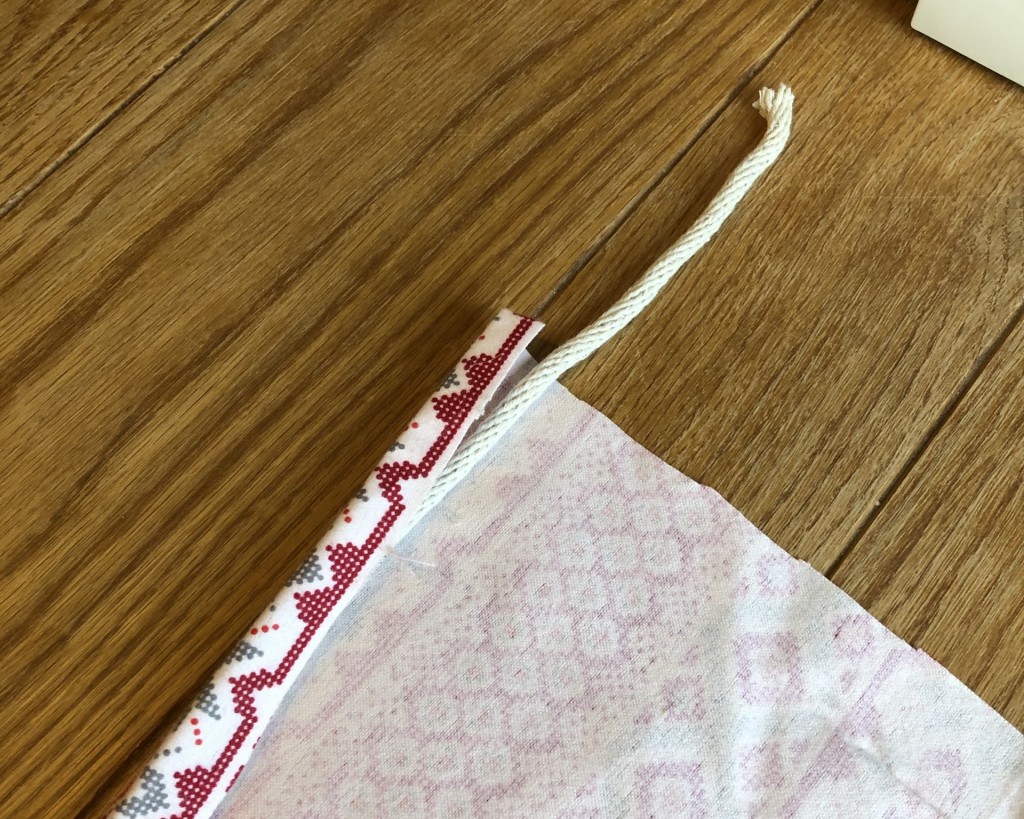
Step 3: Sew your cord into place
Place your fabric with the wrong side up* and the top pointing away from you. Place your cord along the top edge and fold the top of the fabric towards you. You’re going to sew a little pocket for the cord to slide through, so make sure there’s enough fabric that you can run your foot** along the seam without stitching the cord.

* the “wrong side” is what we call the back of your fabric, the side without the pattern, the side you want on the inside of your bag. ** the “foot” is the mechanism around the needle on your sewing machine as shown in this photo.
Step 4: Sew the other two seams
Keeping the wrong side up, fold your fabric in half. This will be the final shape of your bag, so the cord should be at the top and you should have seams to sew across the bottom and one of the sides. Trim any excess fabric if your edges aren’t lining up.
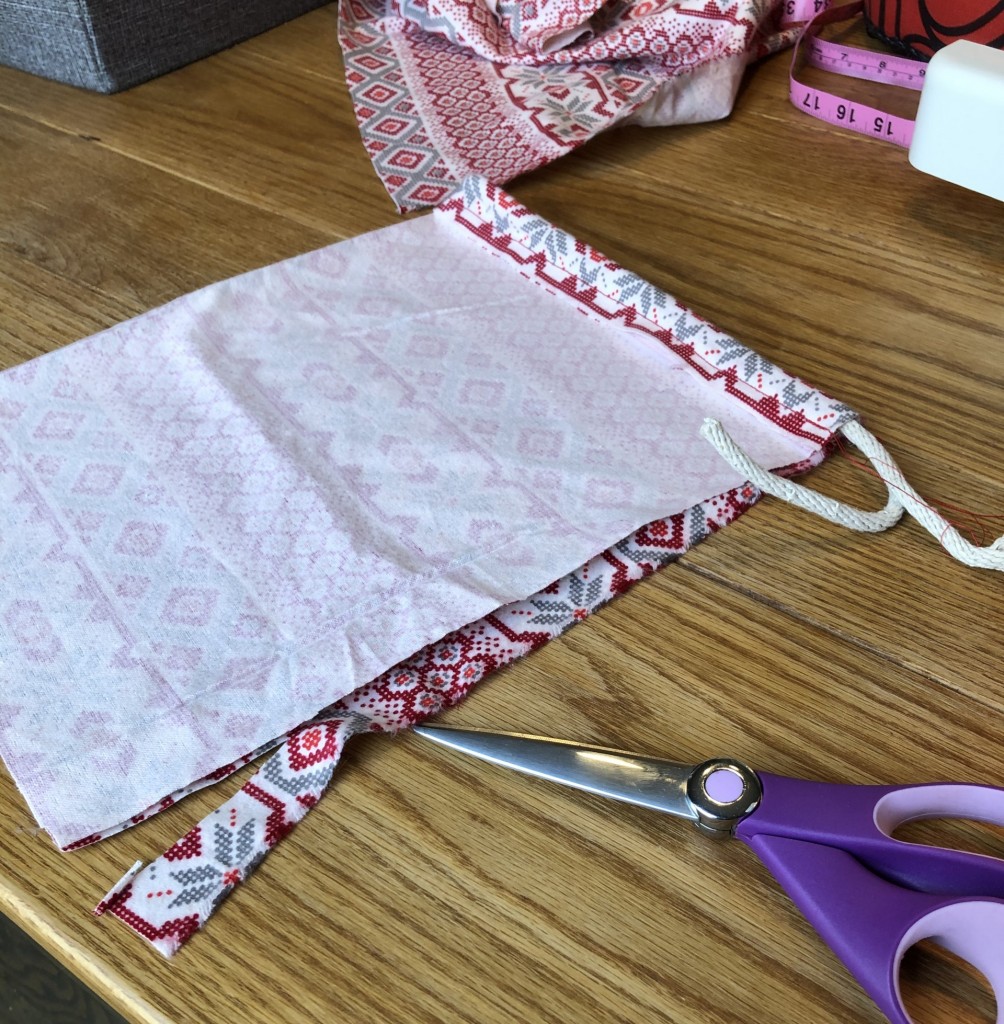
Go ahead and sew these seams. The only tricky part is making sure you don’t sew through the cord/pocket. If you do this, you won’t be able to pull the cord to cinch the bag closed.
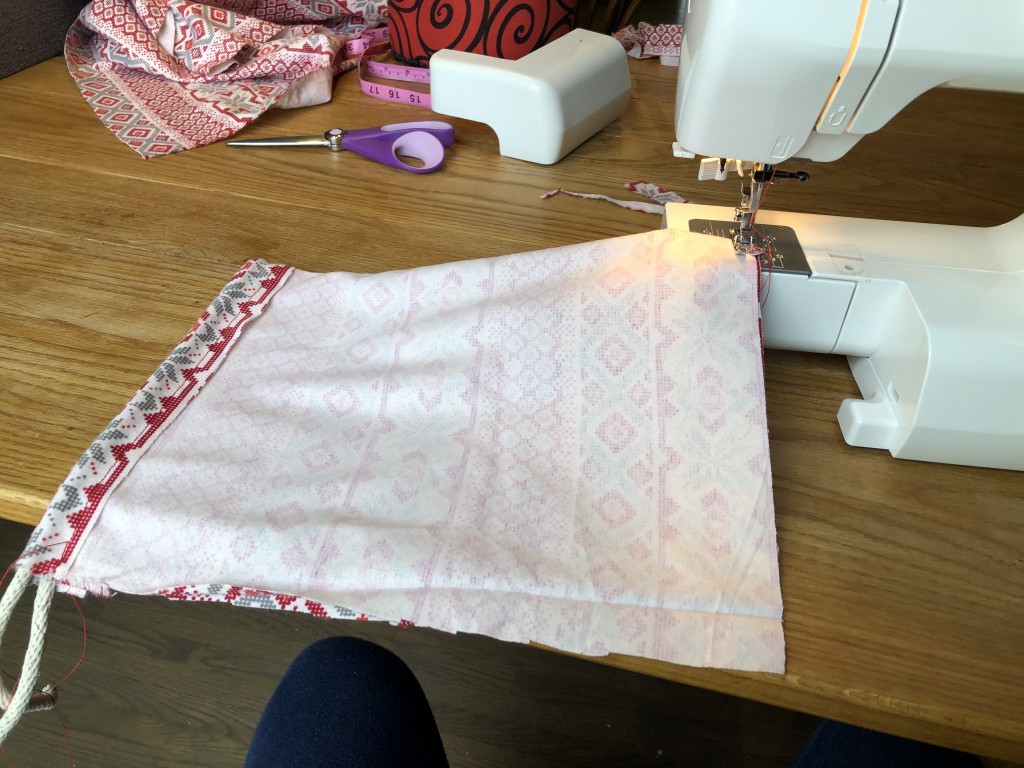
Trim extra thread and turn your bag right side out.
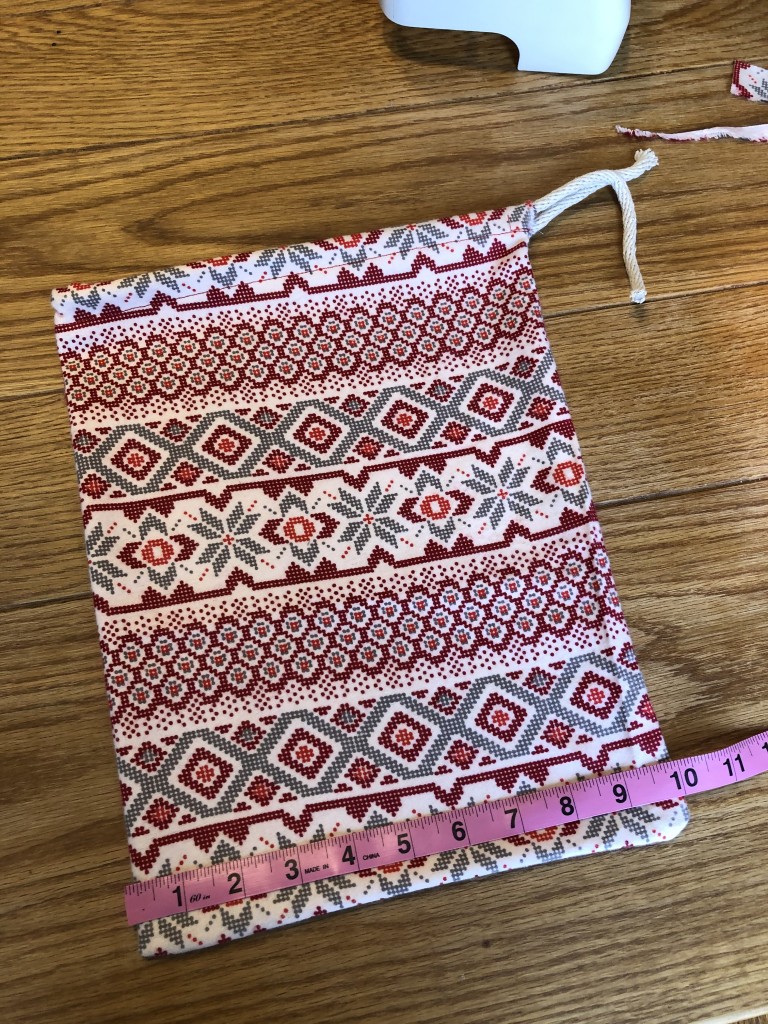
Step 5: Tie knots at each end of the cord
This will prevent the cord from accidentally getting pulled into the pocket when someone is opening their gift. Fishing the cord back out is certainly possible, but a royal pain.
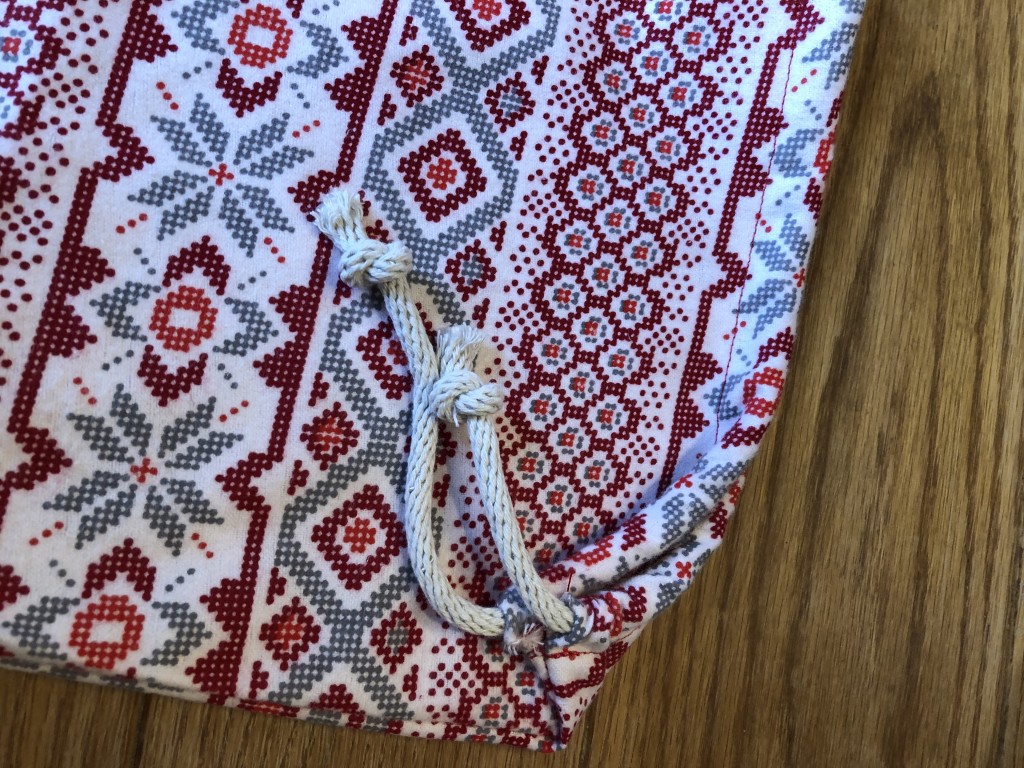
You’re done! You can make as many bags as you want, in a myriad of sizes to meet your gift giving needs!
I have about 24 bags total and the “10×13” bag I made today is the “medium” size bag in my collection. I have a bigger size (roughly twice as big) and a smaller size too. Three yards of fabric will yield about 8 medium and 2 large bags. I like to mix and match my colors and patterns, so I’ve purchased different patterns over the years.
Please drop your questions in the comments below. I’m always happy to answer questions!
And comeback to tell me about your experience if you’re making these reusable gift bags for the first time. I can’t wait to hear about your project!
PS. Does this post feel familiar? It should! It was originally posted a couple of years ago. I’ve updated and republished it because it’s one of my favorite posts.
]]>
A few years ago, I bought a bunch of flannel fabric in adorable holiday prints and sewed up a whole pile of reusable gift bags. This year, I’m honored that my tutorial was selected to be included in the winter edition of the Simple Living Collection!
The Simple Living Collection is a digital bundle of resources to help you settle into a slow and intentional life, reconnecting with each other and nature, and embracing this magical wintery time of rest. There are 70+ tutorials, recipes, ebooks, stories and other activities from more than 50 contributors, just like me. It’s on sale for $25 until Monday, December 13th. Available for immediate download, the PDF is yours to keep and revisit year after year for inspiration. If you’re interested, you can buy your copy here!
The Collection is divided into seven different sections to help families build their own slow-living resource binder. Grow, Raise, Create, Nourish, Healthy Home, Wildcraft, and Family. I’m so excited to share a few of my favorites from each section with you!

This is my favorite section, full of seasonal and holiday crafts! Simple ones that will make for a joyful hour with the kiddos and longer projects to sink deeply into on a slow and quiet morning by the fire. My favorites include:
- Salt dough ornaments from Heather Turner @thehomespun.mom
- Felted fingerless gloves from Emma-Lisa McGee @ourhomeonthehill
- Evergreen dish tutorial from Tara Rondinelli @littlepinelearners
- Natural winter village from Naomi Noyes @ninos.and.nature
- Winter solstice garland from Angela Ruggles @the.nature.atelier
- and MY reusable gift bags!

These three sections combine so nicely to help you feed your family with simple healthy food (hello, micro greens! and I think the extracts make perfect gifts) and sweet treats for your holiday special occasions. My favorites include:
- Homemade extracts from Christy Rucker @christyrucker
- Skillet star bread from Cassandra Evans @northwoodsfolk
- Cardamom sourdough cinnamon rolls from Tess Czulinski @naturally_tess_
- Microgreens made easy from Joey Hodlmair @destinationmommy
- Shiitake log tutorial from Roxanne Ahern @happyholistichomestead
- Winter chicken care from Ashley Comer @slowlivinghomestead
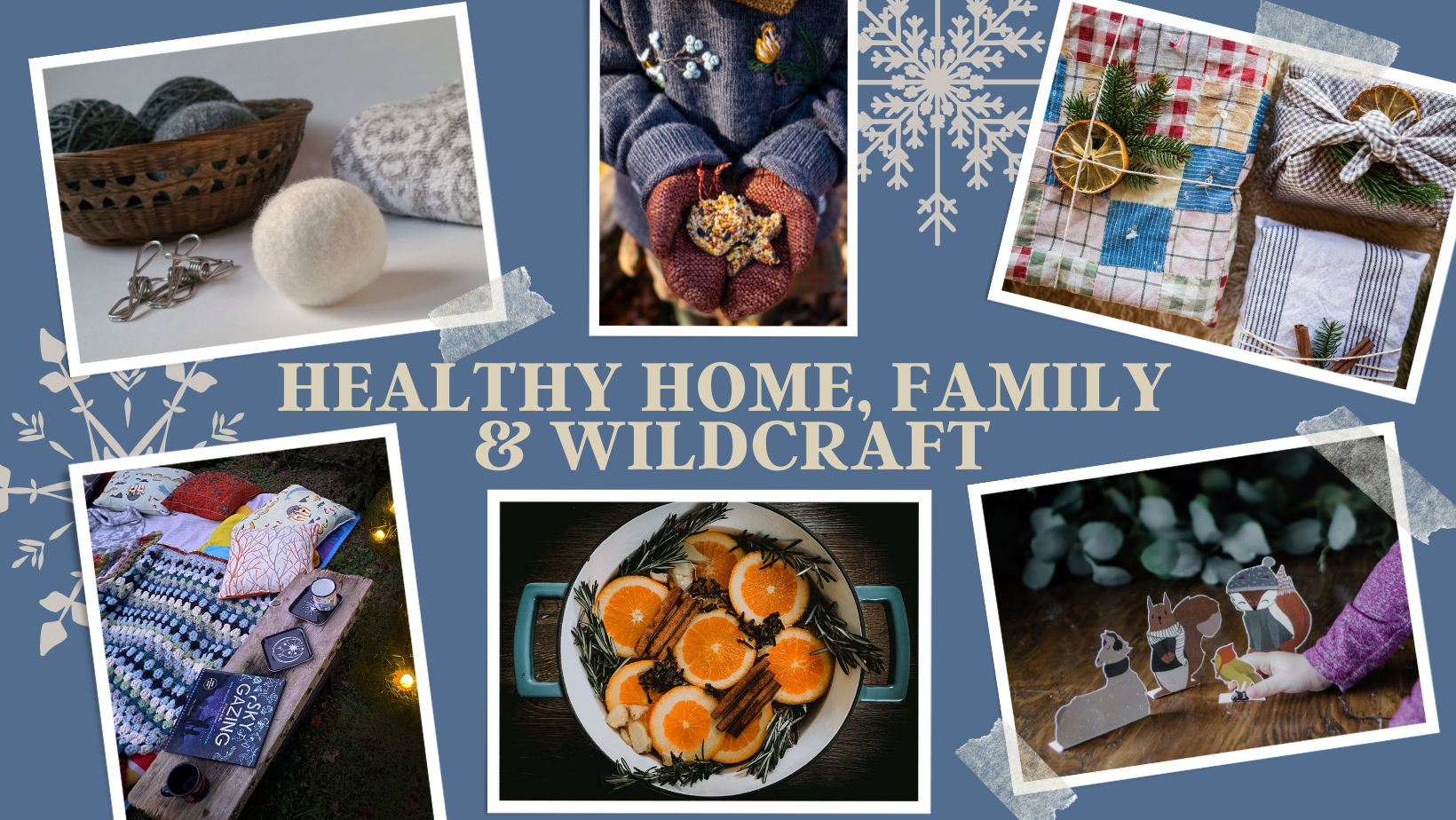
Last, but certainly not least, here are a few of my favorites from the healthy home, family, and wildcraft sections of the Collection. The family section, especially, has lots of fun stories, games, and activities to play with your children, grandchildren, nieces and nephews, or visiting friends with kids during this winter season. There’s plenty here to keep you all entertained!
- Wool dryer balls from Harmonie O’Loughlin @florasfeastbotanicals
- Seasonal simmer pot recipe from Kaila Addis @wildmamarising.ct
- Sustainable gift wrapping (no sewing required!) from Ashley Comer @slowlivinghomestead
- Winter Solstice Guide from Jessie Lehson @wineberryadventurescouts
- Birdseed ornaments from Mari Johnson @bellamartinelli
- Winter puppets from Millie Hernandez @forest.roads
These are only a sampling of the phenomenal work put in by all of the wonderful contributors in this community effort! I’m so excited to be a part of it. The Collection is on sale for $25 until Monday, December 13th and you can get your copy here!
]]>
But what if gifts is your (or your partner’s) love language? And how do we navigate the challenging world of the school Valentine’s Day party?
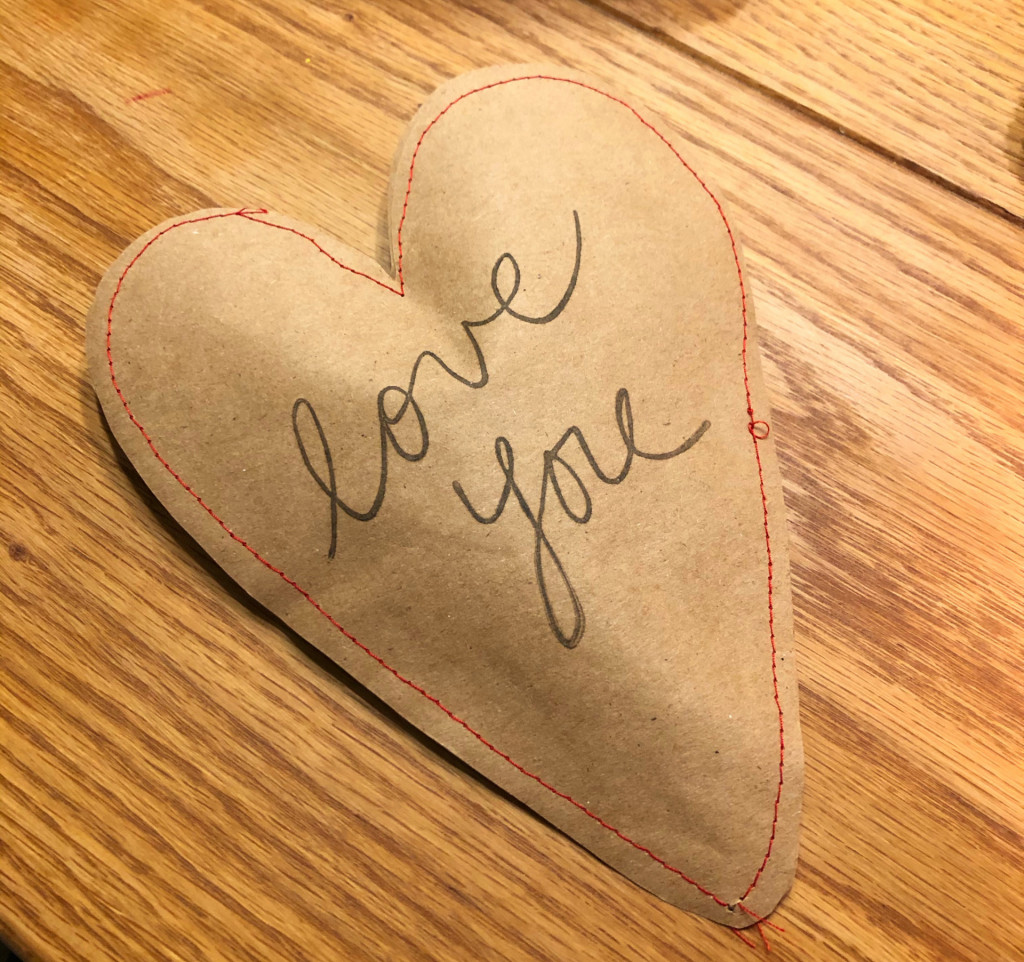
For these situations, I can offer you a couple of suggestions and a little tutorial for homemade, low waste Valentines.
Here are a few recommendations for low- or no-waste gifts:
- Consumables. In my world, gifts of food are always welcome. There are lots of ways to give the traditional gifts of chocolate in a less impactful way.
- Consider buying from a local business and try to avoid packaging. Lots of local coffee and candy shops will sell you bulk candy in a paper bag or your own container, instead of the cellophane wrapped heart box that has become the tradition.
- Or consider buying FairTrade Certified chocolate, so you know the food was raised and harvested in an environmentally and socially responsible way.
- If chocolate isn’t your thing, consider gifting another favorite food, like a special fruit, a favorite meal, or dessert. Bonus points if you support a local, small business or buy your food without packaging.
- Plants. If you’re looking for an alternative to cut flowers, consider a potted plant instead. You can choose something that will continue to grow inside you home, improving your general health and air quality, or a type of plant that can be planted outside in your flower garden in the spring. Don’t overlook the fun option of edible plants. Herbs, like rosemary, or dwarf fruit trees, like lemons and limes, make a really fun gift!
- Something really practical. If your partner is the kind of person who really loves tearing open the wrapping paper, opening a box, and discovering the gift inside, consider gifting them something they actually need. One year, Robbie gave me a dozen pairs of my favorite socks. In the middle of winter in Michigan, this is a grand expression of love!
Ok! On to the homemade Valentine’s tutorial!
My oldest daughter and I were inspired by beautiful homemade valentines created by @tulips_and_a_toolbox, so we decided to have a try at making our own. I was shocked at how well it worked to sew paper, so I just had to share the details with you! (Yes, you read that right, we sewed these paper Valentines… on my sewing machine!)
If you want to make them exactly like ours, you’ll need the following supplies, but this craft is so flexible that I encourage you to substitute supplies you already have in your home. There’s no need to go our a buy anything special for this!
Recommended Supplies:
- Paper – we used brown craft paper from a big roll. You’ll see in the tutorial that this was less than ideal; flat paper would work slightly better if you have it.
- Stamps + ink – we used this to decorate our valentines; if you don’t have stamps and ink at home or you’re doing this craft with younger kids markers, colored pencils, crayons, stickers, and/or stencils would also work great.
- Scissors
- Sewing machine + thread – you can absolutely sew these by hand (I tried it and it was hard, but doable; although the finished product didn’t look nearly as crisp and professional as the ones I sewed on the machine)
Step 1: Create a template
If you want to make your Valentines shapes uniform and consistent, I recommend creating a template that you can trace over and over again. I cut this heart out on my Cricut, but you could easily draw and cut out a template of any shape/size by hand. If you want to stuff your Valentines with a little gift, be sure to make the shape big enough that you’ll be able to fit the gift inside when you sew the two pieces together.
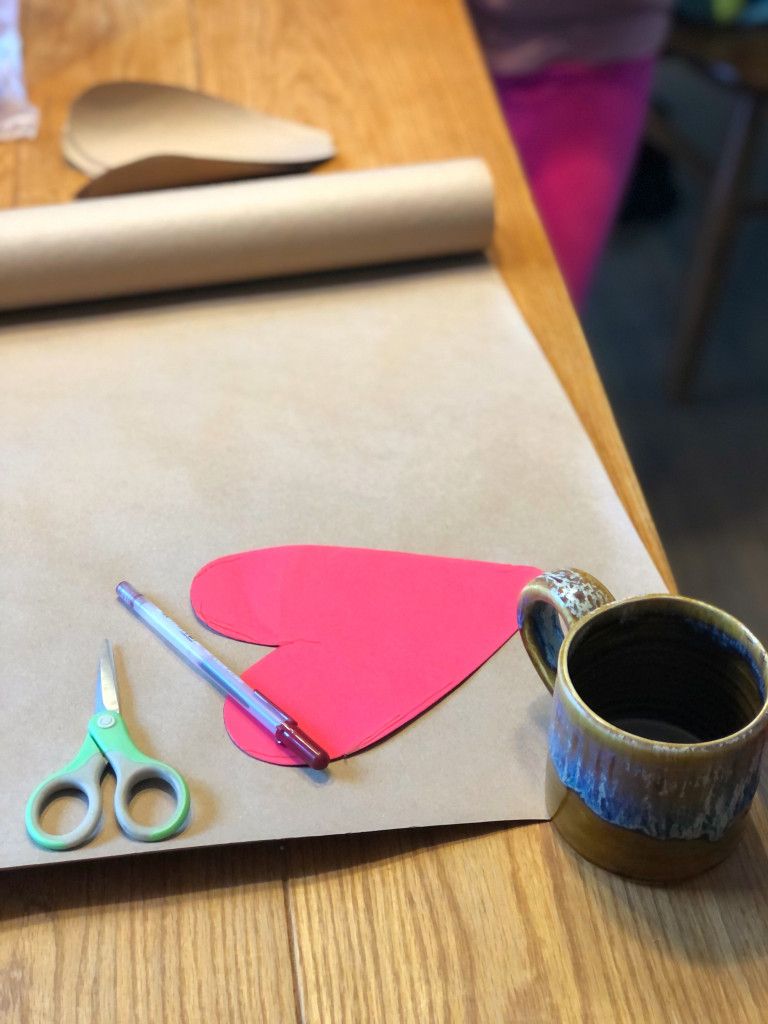
Step 2: Trace your template
Use the template to trace your hearts onto your paper. Remember, you’ll need two paper hearts for each Valentine if you’re planning to sew them together into a cute little pouch.
We used rolled brown paper, which was a little challenging as the paper kept trying to roll back up. As you can see in the photos, I used weights on the corners to hold the paper in place while I was tracing.

Step 3: Cut out your hearts
Cut out all your hearts at once. Again, mine kept wanting to roll up, so I had to flatten them under a heavy book before moving on to the next step.
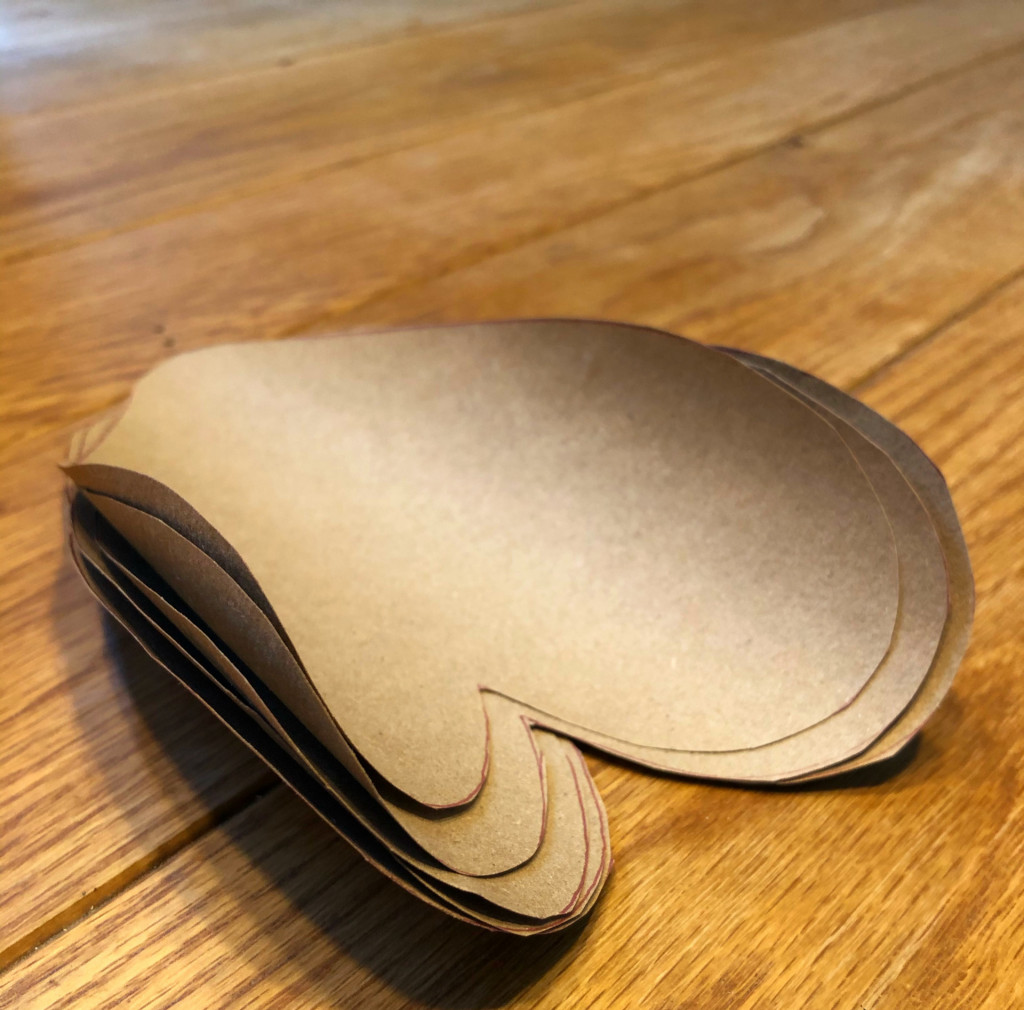
Step 4: Decorate your Valentines
We had a great time using stamps and ink to decorate our Valentines with words and pictures to communicate love and well wishes! We used stamps, but again you could draw free-style or use stencils if you don’t have stamps/ink handy.

Step 5: Stuff and Sew
There are two ways to approach the stuffing/sewing.
If your gift is small enough, like this truffle from my favorite local coffee/candy shop (Sweetland Candies), mints, or those little candy hearts with the cute messages, you can sew the entire way around the edge of your Valentine. I recommend sewing at least half way around, pausing to stick your little gift into the pouch, and then sewing the rest of the way.
Here are a few tips while sewing:
- Match your two pieces of paper, making sure the decorated side(s) are facing out. Hold them together and sew around the entire edge.
- I found that I didn’t need to pin or tape them in place, holding the two pieces together with my left hand while steering with my right seemed to work just fine.
- I also found that it didn’t seem to matter where on the heart I started and ended my sewing.
- If you’re an experienced sewer, have fun with various stitches and edging techniques! I decided I liked the simple look of the plain red stitch on the plain brown paper.
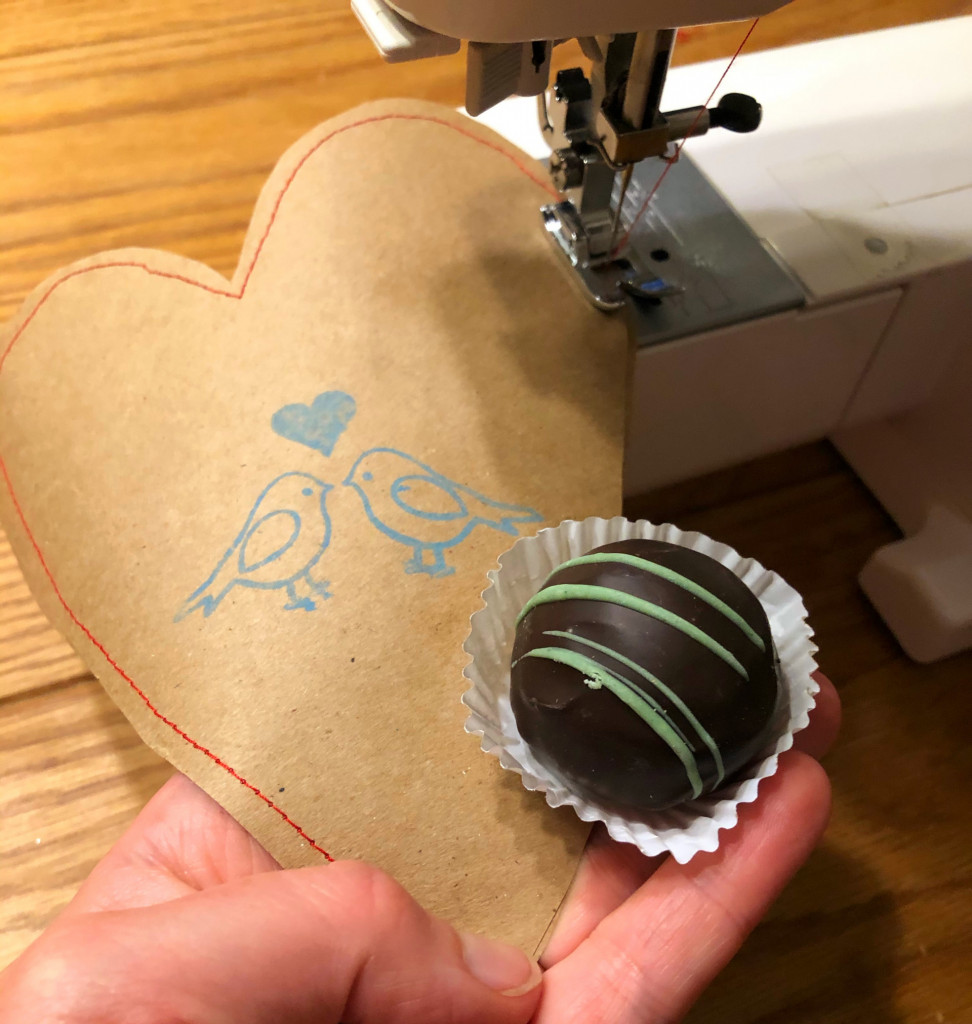
If your gift is bigger, like the fun dip candy my daughter wanted to give her third grade classmates, you can sew most of the way around the edge, leaving the top open.
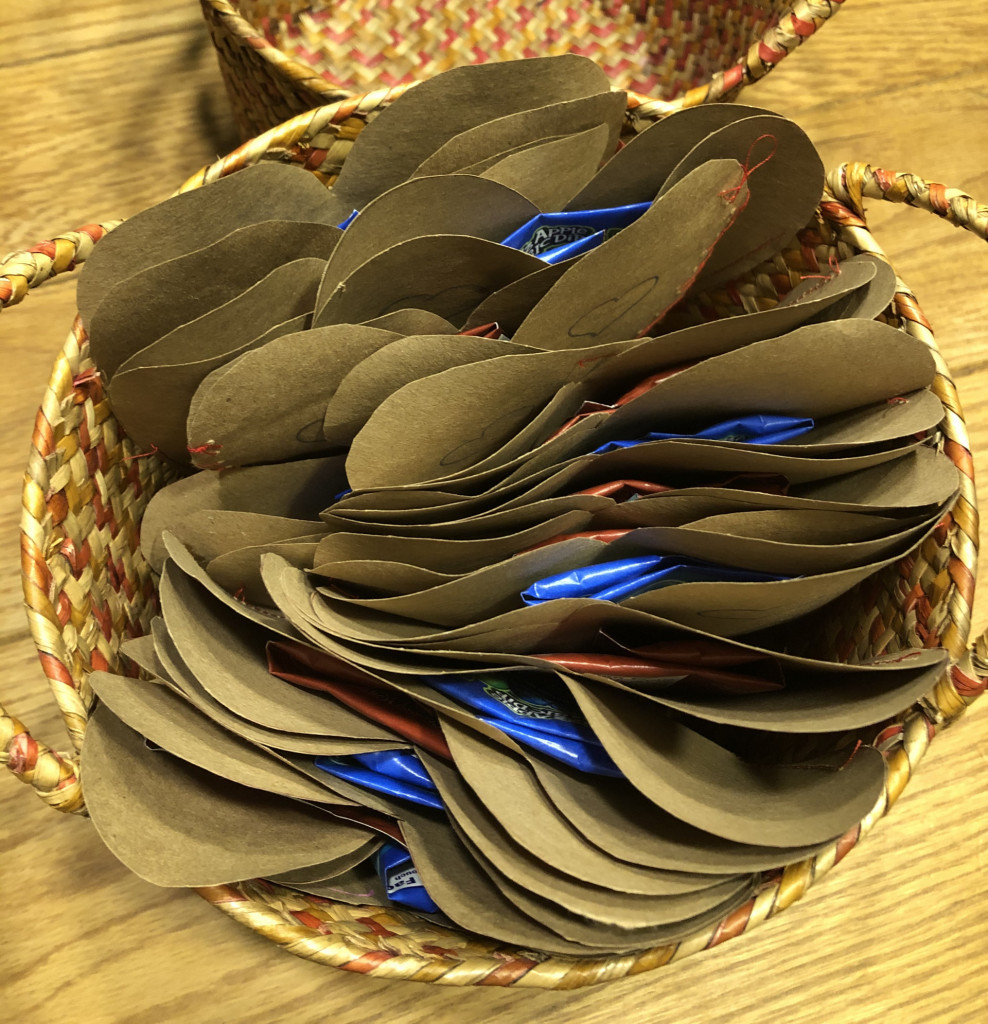
Voila! You’re done! You can make as many of these cute little Valentines as you want, in a myriad of sizes and shapes, depending on your gift giving needs, time available and attention span (especially if you’re doing this craft with little ones)!
Please drop your questions in the comments below. I’m always happy to answer questions!
And comeback to tell me about your experience! I can’t wait to see your beautiful homemade Valentines! If you share photos on Instagram or Facebook, please tag me @carbonfreefamily so I can celebrate your amazing results with you!
]]>
I also firmly believe that you are not obligated to keep gifts that do not bring you joy or support the life you are trying to live. This does not make you ungrateful. Yes, someone spent time and money choosing the gift for you, but they wouldn’t want you to compromise your values to keep something that doesn’t fit… your body, your lifestyle, or your values.

You can be grateful and still not keep every gift you receive.
We’re all trying to build the life we want to live. I’m focused on a simple life, built on minimalist and sustainable values. It is a core value that I do not keep things in my life that do not bring me joy. And in general, stuff does not bring me joy.
So what do I do when someone gives me a gift that doesn’t support my life? I pass it on to someone who will appreciate it and use it!
Interested in building more sustainable habits in 2021? Please join my upcoming virtual workshop: Kickstart Your Sustainability Journey!
Here are my simple strategies for passing on gifts:
- Exchange or return it.
I think this can be done in a way that honors both the gift giver and my values. It might be important to be honest with the gift giver if you go this route, but I trust that if you approach the conversation with love and kindness, you’ll leave even more connected to each other. This is an especially good strategy if the color or style doesn’t fit your life, but the gift comes from a store that has other things that would fit you better.
2. Regift it
I LOVE regifting things! It doesn’t have to be Christmas or their birthday, giving someone a gift on a non-holiday can be even more special! It’s worth noting that this is only a kindness if you truly believe the gift will be a blessing to someone else. Regifting at random just passes the clutter (or act of donating) on to someone else.
3. Donate it
There are plenty of people in need these days. The gifts that don’t quite fit you could be very helpful for someone who is stretching to make ends meet. Donate unwanted things (maybe as part of a January clean out? see below for more on this) to your local charity of choice or directly to an individual in your community using online groups like Buy Nothing group on Facebook
I can’t help but highlight the opportunity that’s just below the surface this time of year… the annual purge, clean out, or whatever you choose to call the opportunity to review your accumulated stuff to make sure it is still truly bringing value to your life. If not, pass it on!
After Christmas is an especially good time to do this with kids. If you’re new to this sort of activity, give yourself grace and time (it might take longer and more energy than you think, but I swear it’s worth it to surround yourself with only things that fit your life) and consider approaching only one area of your house at a time. And if you need help, ask for it! I’m happy to support you on this journey and can design a one-on-one coaching program to meet your specific needs. Send me an email (at carbonfreefamily@gmail.com) or complete this form to start discussing the possibilities.
Also worth highlighting in a little more detail is the growing number (and value) of groups like my local Buy Nothing group on Facebook. If you’ve never heard of a group like this, the basic premise is such: the group is a platform for giving away and asking for things you need with NO exchange of money (or any sort of value, trades usually aren’t allowed either). You can give away just about anything you want, including stuff, services (like offering to cook a meal for someone or teaching someone to mend their own clothes), or time (like offering to meet people for a coffee date or picnic). Alternatively, you can ask for the same types of things. I love this model because you’re giving things directly to a person who has 1) asked for them or 2) expressed a need, rather than potentially overwhelming a charity with unwanted stuff.
Getting to know your local Buy Nothing group is a great strategy to manage your stuff throughout the year. I’m constantly giving things away using this group and asking for things you need. I always feel like I should give more than I take from groups like this, but they’re an amazing resource to ask for things you need too! Last summer, I picked up kefir starter and used roller skates for both my kids from my Buy Nothing group… for free!
Comment with your questions and additional recommendations below!
]]>Please join my upcoming workshop… Kickstart Your Sustainability Journey! This 6-week online workshop will change the way you think about sustainability, flipping your mindset so that sustainability becomes a natural part of every decision you make and creating easy sustainable habits. Find more information and register here!
